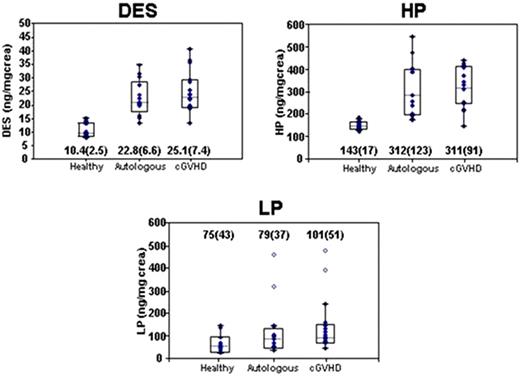Abstract
Abstract 1156
Poster Board I-178
cGVHD is the main cause of impaired quality of life, morbidity and mortality in patients surviving after allogeneic transplantation. To date, no validated biomarkers for diagnosis and follow-up of cGVHD have been established. Among proposed pathophysiological mechanisms, one involves increased turnover of extracellular matrix components as a result of immune-mediated tissue destruction. We hypothesized that analysis of urinary excretion of degradation peptides from collagen (hydroxylysylpyridinoline [HP] and lysylpyridinoline [LP]) and elastin (desmosine [DES]) using high-sensitivity nano-flow liquid chromatography tandem mass spectrometry (nanoLC-MS/MS) might lead to identification of potential biomarkers in patients with cGVHD.
We elected to compare 3 groups: 16 allogeneic transplant recipients with newly diagnosed or relapsing cGVHD before initiation of systemic immunosuppressive therapy (group A), 13 pts with lymphoma who underwent autologous transplantation, in order to measure the impact of high-dose chemotherapy (group B) and 10 healthy volunteers (group C). Clinical characterization of cGVHD was performed according to NIH criteria. Pts already on glucocorticoids and those with bloodstream infection or proteinuria were excluded. Morning urine samples were collected in fasting subjects, then processed and frozen at -80°C until analysis by nanoLC-MS/MS. Samples were purified using mixed-mode strong cation exchange cartridges, derivatized using propionic anhydride and analyzed with nanoLC-MS/MS.
Pts with cGVHD (group A) were collected at a median of 229 (107-2966) days post transplant; 8 pts had de novo cGVHD, 8 presented with obvious clinical flare-up and 3 had previously suffered from acute GVHD. cGVHD was mild in 1 (6%), moderate in 8 (50%) and severe in 7 (44%) pts. Affected organs included mouth in 12 pts, skin in 11, liver in 11, eyes in 5, GI tract in 5, joints/fascia in 2, genital tract in 1 and lungs in 1. Thrombocytopenia was present in 4 (25%) pts and eosinophilia in 7 (44%). All transplants had been performed for hematological malignancies, using myeloablative (7 pts) or reduced-intensity conditioning (9 pts). Donors were HLA-identical siblings (13 pts), 10/10 (2 pts) or 9/10 (1 pt) unrelated volunteers. Stem cell source was peripheral blood in all but one pts. Pts from group B were collected at a median of 123 (90-377) days post transplant. As shown in enclosed figure, urinary concentrations of DES and HP in group A and B were similar, but both groups showed a marked increase in levels of these compounds compared to group C (p<0.0001, except HP in group B vs C: p=0.0003). We observed no difference in concentrations of LP, a bone collagen cross-linker, between studied groups. Total and free forms of studied peptides showed excellent correlation.
We found an increase in the urinary excretion of extracellular matrix components in patients with cGVHD. Our results also suggest that the conditioning regimen has significant early effects on the turnover of elastin and collagen. Prospective sampling in a cohort of allogeneic transplant recipients is currently underway to further elucidate the kinetics and the value of HP and DES as potential biomarkers for cGVHD.
No relevant conflicts of interest to declare.
Author notes
Asterisk with author names denotes non-ASH members.


This feature is available to Subscribers Only
Sign In or Create an Account Close Modal